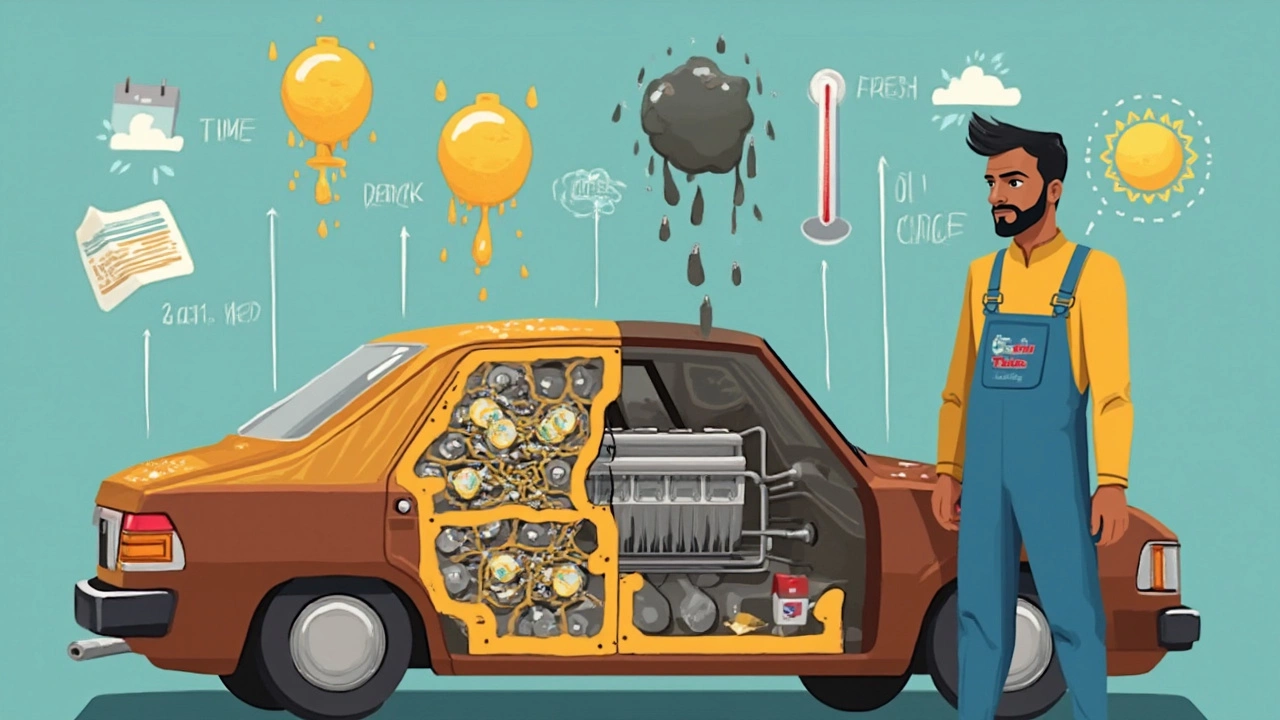How Long Can Engine Oil Sit Before It Goes Bad?
 May, 30 2025
May, 30 2025
Ever looked at your car sitting in the driveway for months and wondered if the oil is still okay? Plenty of people assume oil lasts forever just because their car hasn't racked up miles, but that's not the case.
Engine oil breaks down over time, even if the engine isn’t running. Air, moisture, and temperature swings start to mess with it the minute you pour it in. So storing your ride for ages without changing the oil isn’t a safe bet—sludge, rust, and even engine damage can creep up when you’re not watching.
Want to know how long is too long for oil to sit? Stick around, and you'll pick up easy ways to spot bad oil, real risks of ignoring the problem, and how to make your oil last longer. Spoiler: waiting years is a recipe for trouble, even if your car never leaves the garage.
- Why Oil Goes Bad When Sitting Idle
- Shelf Life: How Long Oil Can Sit in an Engine
- What Happens If You Use Old Oil?
- Signs Your Oil Has Gone Bad
- Tips to Maximize Oil Life
Why Oil Goes Bad When Sitting Idle
It’s easy to forget, but engine oil doesn’t just hang out and stay perfect when your car is parked for months. The top reason oil goes bad is exposure to air and moisture even if you never turn the key. This process is called oxidation, and it slowly changes the chemistry of the oil, making it less effective at protecting engine parts.
Another sneaky problem is condensation. Every time temperatures swing—think cold garage at night, warmer by day—tiny water droplets form inside your engine. Over time, this moisture seeps into the oil, which can lead to rust and gunk buildup inside critical engine pieces. That’s how what started as clean oil can turn into a sludge magnet without the engine ever running.
And here’s something most folks don’t think about: old oil absorbs particles and acids leftover from previous use. Even after you switch off the engine, remnants of fuel, dirt, and tiny wear metals stay trapped in the oil and start to react. Parked cars with engines that haven’t warmed up in months won’t burn off these nasties—they just keep cooking quietly, making the oil less able to do its job.
Synthetic oils hold up better than conventional, but neither is invincible. No matter the type, if oil sits too long the detergents and additives inside lose their kick. That means there’s less cleaning and corrosion protection as time rolls on.
Long story short: engine oil shelf life matters, not just how many miles you drive. Leaving oil to sit isn’t harmless, and it sets your engine up for problems the next time you fire it up.
Shelf Life: How Long Oil Can Sit in an Engine
If you don't drive much, it might surprise you that engine oil actually expires even if you barely put any miles on your ride. Most car makers say engine oil should be changed every 6 to 12 months, even if you haven’t hit the recommended mileage. This isn’t just a money grab—oil loses its protective qualities over time, right inside your engine.
When oil sits, it’s still exposed to leftover fuel, moisture, and tiny bits of metal or dirt left from previous drives. These things slowly make the oil less effective at protecting engine parts. But there's another problem: modern oils contain additives that keep engines clean and prevent wear. These additives break down as time passes, so oil just can’t do its job after sitting too long.
If we’re talking specifics, most experts agree regular oil should not sit in an engine longer than a year, and synthetic oils tap out around the same time—maybe a few months longer if you’re stretching it. Hot weather, high humidity, and temperature swings can make oil go bad even faster.
- If your car sits mostly unused, set a calendar reminder—don’t just rely on miles driven for oil changes.
- After a year, even *freshly poured* oil inside a sealed engine has likely lost its punch and may turn acidic, which can slowly eat away at engine parts.
- If you store your car in a humid place or take lots of short trips, swap the oil even sooner. Condensation and fuel dilute the oil’s protective power fast.
The real takeaway here: the engine oil shelf life isn’t just about the bottle’s label or how much you drive. It’s about time, temperature, and what your engine faces while it’s sitting still.

What Happens If You Use Old Oil?
Driving a car with old oil isn’t just a bad idea—it’s a direct route to engine trouble. Once oil sits for too long, it starts losing the power to lubricate, clean, and protect your engine. Its chemical structure changes, and things get thick, sticky, and dirty inside that metal heart.
Using worn-out oil ramps up wear on metal parts. Metal shaving build-up, hot spots, and gunky sludge clog small channels. This kills efficiency and can torch your fuel economy up to 5%. Even more seriously, mechanics regularly find older vehicles with full engine failures just because the oil was left unchanged for too long.
Here’s what can go wrong if you rely on old oil:
- Engine oil shelf life really matters! After a year of sitting, oil can form varnish and sludge—even if you haven’t driven a single mile.
- Thick oil doesn’t flow quickly, meaning moving parts get less protection. Cold starts especially suffer—metal grinding against metal wears things out fast.
- Additives disappear over time, so things like anti-rust agents and detergents stop working, making corrosion a serious risk.
- Rings and seals can dry, crack, or get coated in deposits, causing leaks or poor compression.
- There’s a higher risk of overheating, since dirty oil can’t carry away engine heat as well.
"Most oil manufacturers recommend changing oil at least every 12 months, regardless of mileage, because oil sitting in an engine will degrade from moisture, acids, and oxidation." – Car Care Council
If you want some actual numbers, check out the numbers below showing engine issues linked to old oil:
| Time Oil Sits | Chance of Sludge | Risk of Corrosion | Avg. Engine Wear Increase |
|---|---|---|---|
| 6 Months | Low | Minimal | Up to 5% |
| 12 Months | Moderate | Noticeable | Up to 15% |
| 18+ Months | High | Major | 20% or more |
If the oil has sat more than a year or looks dark, gritty, or milky, don’t risk it. Change it before hitting the road. Saving a few bucks on oil is not worth blowing an expensive engine.
Signs Your Oil Has Gone Bad
So how do you actually know if your engine oil has gone downhill? It’s not always about clocking miles. Oil can get ruined just sitting too long. Your best move is to check for these signs before that next start-up.
- Color Change: Fresh oil is a clear amber color. If it looks dark, gritty, or cloudy, it’s a red flag. Dark oil usually means it’s full of contaminants or has started to oxidize.
- Strange Smell: Open the oil cap and take a whiff. If you catch a sour, burnt, or “off” smell, that means the oil’s chemical makeup is breaking down.
- Thick, Sludgy Texture: Healthy oil pours smoothly between your fingers. Old oil can feel sticky, thick, or even like sludge. That gunk won’t protect your engine at all.
- Separation or Milky Appearance: If you see a milky layer or separation, moisture has gotten in. Water and oil don’t mix—this is usually a sign of condensation or even a coolant leak.
If you’re not sure, here’s a quick look at what fresh vs. old engine oil can look like:
| Oil Condition | Appearance | Scent | Feel |
|---|---|---|---|
| Fresh | Clear amber, no particles | Neutral, mild | Slick, thin |
| Old or Bad | Dark, gritty, sometimes milky | Burnt, sour | Sticky, thick, sometimes sludgy |
Don’t just trust your eyes. According to car maintenance guides, even if oil shelf life looks okay, if it’s been sitting for over a year—especially in a car that isn’t driven much—it loses critical protection and can corrode vital parts. A quick oil check only takes a few minutes, and it might save you from headaches down the road.

Tips to Maximize Oil Life
Letting your engine oil hang around too long isn’t great, but there are ways to stretch its life and help your engine stay happy. Most people forget oil can spoil without ever leaving the driveway, so a little attention goes a long way. Here’s what actually works if you want your oil to last as long as possible:
- Stick to sealed containers. If you keep your oil supply in the original, tightly sealed bottle, it can last up to five years on the shelf. Opened bottles attract moisture and air, which break it down way faster—think two years at most after opening.
- Control the temps. Store extra engine oil between 40°F and 80°F. Wild swings (like what happens in garages) can break the oil down. Got leftover oil in your car’s engine? Park it in a cool, dry place to slow the aging.
- Avoid short trips. Engines rarely warm up enough on quick errands, which lets water and unburnt fuel mix with your oil and send it downhill fast. Try to take your car for a longer spin every now and then if it’s mostly sitting.
- Change the filter every time. Old filters trap junk and let it back into the clean oil, sludging everything up. Always swap it out when you change the oil.
- Don’t ignore the calendar. Even with low mileage, most carmakers recommend changing oil every 6-12 months if your car stays parked a lot. Time breaks down the oil, not just driving distance.
Here’s a quick look at storage guidelines and timeframes that help maximize your oil’s lifespan:
| Oil Storage/Use | Recommended Lifespan |
|---|---|
| Sealed, unopened bottle | Up to 5 years |
| Opened bottle, resealed | 1-2 years |
| In engine (rarely used car) | 6-12 months |
| Regularly driven vehicle | Follow carmaker interval or at least annually |
If you really care about your engine oil shelf life, keep it sealed, stable, and don't try to save money by pushing it too far. A cheap oil change costs way less than fixing a ruined engine later on.